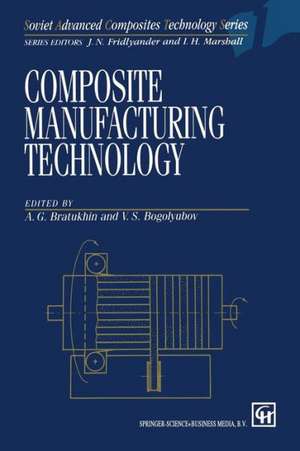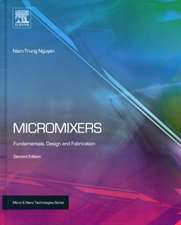Composite Manufacturing Technology: Soviet Advanced Composites Technology Series, cartea 1
Editat de A.G. Bratukhin, V.S. Bogolyuboven Limba Engleză Paperback – 23 oct 2012
| Toate formatele și edițiile | Preț | Express |
|---|---|---|
| Paperback (1) | 3015.53 lei 6-8 săpt. | |
| SPRINGER NETHERLANDS – 23 oct 2012 | 3015.53 lei 6-8 săpt. | |
| Hardback (1) | 3021.68 lei 6-8 săpt. | |
| SPRINGER NETHERLANDS – 31 oct 1994 | 3021.68 lei 6-8 săpt. |
Preț: 3015.53 lei
Preț vechi: 3677.47 lei
-18% Nou
Puncte Express: 4523
Preț estimativ în valută:
577.02€ • 628.75$ • 486.22£
577.02€ • 628.75$ • 486.22£
Carte tipărită la comandă
Livrare economică 23 aprilie-07 mai
Preluare comenzi: 021 569.72.76
Specificații
ISBN-13: 9789401045537
ISBN-10: 9401045534
Pagini: 448
Ilustrații: XI, 433 p.
Dimensiuni: 155 x 235 x 24 mm
Greutate: 0.62 kg
Ediția:1995
Editura: SPRINGER NETHERLANDS
Colecția Springer
Seria Soviet Advanced Composites Technology Series
Locul publicării:Dordrecht, Netherlands
ISBN-10: 9401045534
Pagini: 448
Ilustrații: XI, 433 p.
Dimensiuni: 155 x 235 x 24 mm
Greutate: 0.62 kg
Ediția:1995
Editura: SPRINGER NETHERLANDS
Colecția Springer
Seria Soviet Advanced Composites Technology Series
Locul publicării:Dordrecht, Netherlands
Public țintă
ResearchCuprins
1 Main technological aspects of the manufacture of composite parts and assembly.- 1.1 Materials-science aspects of composite-structure design.- 1.2 Technological concepts and development of production.- 1.3 Application of composites in passenger aircraft structures.- References.- 2 Technology for prepreg production of semifinished products of polymeric composite materials.- 2.1 Classification of methods for prepreg production.- 2.2 PCM semifinished products obtained by liquid-phase combination of binders.- 2.3 PCM semifinished products obtained by solid-phase combination of components.- 2.4 Equipment for production of prepregs.- References.- 3 Forming of parts and components of fibre composites by winding.- 3.1 Process theory and classification of part-forming methods.- 3.2 Formatting pressure.- 3.3 Surface reinforcing lines.- 3.4 Classification of winding processes.- 3.5 Factors defining winding-component and prepreg properties: basic technological conditions and control of the winding process.- 3.6 Control of the winding process.- 3.7 Equipment for product forming by winding.- — Principles of operation of equipment. Technical data.- — Forming of parts and components of fibre composites by winding.- 3.8 Winding-process automation: process programming on NC machines and preparation problems in control programs for reinforcing.- References.- 4 Shape-forming and curing of composite-material parts.- 4.1 Physical and chemical mechanisms of vacuum-autoclave moulding.- 4.2 Mathematical modelling of the structure-manufacturing process through vacuum-autoclave moulding.- 4.3 Development of working processes in part manufacture by vacuum-autoclave moulding.- References.- 5 Machining of polymer-composite materials.- 5.1 Polymer-composite material (PCM) as the object ofmachining.- 5.2 Tool materials and cutting tools for PCM machining.- 5.3 Choice of cutting conditions in PCM machining.- 5.4 Special PCM machining methods with material removal.- References.- 6 Composite-material part joining.- 6.1 Joint classification: types of joints and their applications.- 6.2 Mechanical-joint design.- 6.3 Riveted joints in composite-material structures.- 6.4 High-stress bolted joints.- 6.5 Adhesive-joint design.- 6.6 Combined-joint design.- 6.7 Technological developments in joint strength.- 6.8 Technology of riveted-joint formation.- References.- 7 Non-metallic-based honeycomb cores.- 7.1 Polymeric-paper-based honeycomb cores.- 7.2 Fibre-glass-cloth-based honeycomb cores.- 7.3 Honeycomb-core application in aircraft structures.- References.- 8 Non-destructive testing or composites parts.- 8.1 Introduction.- 8.2 Acoustic methods.- 8.3 Microwave method.- 8.4 Electrical methods.- 8.5 Radiation methods.- 8.6 Infrared and thermal methods.- 8.7 Holographic method.- References.- 9 Three-dimensional tooling.- 9.1 Introduction.- 9.2 Design of composite thin-walled tooling for manufacture of metal—polymeric line-forming parts.- 9.3 Forming tooling-structural diagrams.- 9.4 Design and analysis of thin-walled tooling structures.- 9.5 Shell analysis for the action of local loads.- 9.6 Tooling analysis for the action of functional loads.- 9.7 Supporting-structure wall thickness for stability under compressive forces.- 9.8 Stiffness analysis and selection of tooling-frame structural parameters.- References.
Recenzii
The book is a useful addition to the library of any practising composite manufacturing engineer... Composites Manufacturing; The book is a useful addition to the library of any practising composite manufacturing engineer... - Composites















